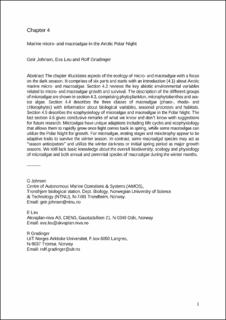| dc.contributor.author | Johnsen, Geir | |
| dc.contributor.author | Leu, Eva | |
| dc.contributor.author | Gradinger, Rolf | |
| dc.date.accessioned | 2021-03-18T14:28:42Z | |
| dc.date.available | 2021-03-18T14:28:42Z | |
| dc.date.created | 2020-08-24T14:07:40Z | |
| dc.date.issued | 2020 | |
| dc.identifier.isbn | 978-3-030-33208-2 | |
| dc.identifier.uri | https://hdl.handle.net/11250/2734299 | |
| dc.description.abstract | Microalgae have unique adaptions including low metabolic activity, utilization of lipid storage, and resting stage formation to survive the Polar Night. Some species are mixotrophic or heterotrophic and do survive periods that are not favorable for photosynthetic (autotrophic) growth, such as the Polar Night. In addi- tion, the autotrophic and mixotrophic species seem to maintain the key components of the photosynthetic apparatus intact during the dark period, which allows them to resume growth rapidly once light comes back in spring. In contrast, some macroal- gal species may act as “season anticipators” and utilize the winter darkness or early spring period as their major growth seasons. This chapter elucidates aspects of the ecology of micro- and macroalgae with a focus on the dark season. It is comprised of six parts and starts with an introduction (Sect. “Introduction”) about Arctic marine micro- and macroalgae. Section “The Key Abiotic Environmental Variables Related to Micro- and Macroalgae” reviews the key abiotic environmental variables related to micro- and macroalgal growth and survival. The seasonal development of the different groups of microalgae is described in Sect. “Microalgae”, comprising phytoplankton, microphytobenthos, and sea-ice algae. Section “Macroalgae” intro- duces the three classes of macroalgae (phaeo-, rhodo-, and chlorophytes) with infor- mation about biological variables, seasonal processes, and habitats. Section “Ecophysiology of Algae in the Polar Night” sheds light on the ecophysiology of microalgae and macroalgae in the Polar Night, using selected examples. The last Section “Conclusive Remarks” summarizes our current state of knowledge and provides some conclusions derived from it. | en_US |
| dc.language.iso | eng | en_US |
| dc.publisher | Springer | en_US |
| dc.relation.ispartof | Polar night marine ecology - life and light in the dead of night | |
| dc.title | Marine Micro- and Macroalgae in the Polar Night | en_US |
| dc.type | Chapter | en_US |
| dc.description.version | acceptedVersion | en_US |
| dc.source.pagenumber | 67-112 | en_US |
| dc.identifier.doi | http://dx.doi.org/10.1007/978-3-030-33208-2_4 | |
| dc.identifier.cristin | 1824830 | |
| dc.relation.project | Norges forskningsråd: 214271,226417,244319,245923,300333,223254 | en_US |
| dc.description.localcode | This is a post-peer-review, pre-copyedit version of an article. Locked until 9/4-2022 due to copyright restrictions. The final authenticated version is available online at: https://link.springer.com/chapter/10.1007/978-3-030-33208-2_4 | en_US |
| cristin.ispublished | true | |
| cristin.fulltext | postprint | |
| cristin.qualitycode | 1 | |
